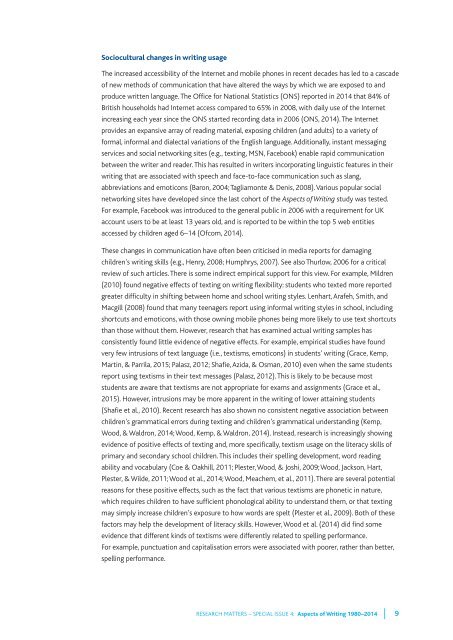Research Matters
N6fqJH
N6fqJH
Create successful ePaper yourself
Turn your PDF publications into a flip-book with our unique Google optimized e-Paper software.
Sociocultural changes in writing usage<br />
The increased accessibility of the Internet and mobile phones in recent decades has led to a cascade<br />
of new methods of communication that have altered the ways by which we are exposed to and<br />
produce written language.The Office for National Statistics (ONS) reported in 2014 that 84% of<br />
British households had Internet access compared to 65% in 2008, with daily use of the Internet<br />
increasing each year since the ONS started recording data in 2006 (ONS, 2014).The Internet<br />
provides an expansive array of reading material, exposing children (and adults) to a variety of<br />
formal, informal and dialectal variations of the English language.Additionally, instant messaging<br />
services and social networking sites (e.g., texting, MSN, Facebook) enable rapid communication<br />
between the writer and reader.This has resulted in writers incorporating linguistic features in their<br />
writing that are associated with speech and face-to-face communication such as slang,<br />
abbreviations and emoticons (Baron, 2004;Tagliamonte & Denis, 2008).Various popular social<br />
networking sites have developed since the last cohort of the Aspects of Writing study was tested.<br />
For example, Facebook was introduced to the general public in 2006 with a requirement for UK<br />
account users to be at least 13 years old, and is reported to be within the top 5 web entities<br />
accessed by children aged 6–14 (Ofcom, 2014).<br />
These changes in communication have often been criticised in media reports for damaging<br />
children’s writing skills (e.g., Henry, 2008; Humphrys, 2007). See also Thurlow, 2006 for a critical<br />
review of such articles.There is some indirect empirical support for this view. For example, Mildren<br />
(2010) found negative effects of texting on writing flexibility: students who texted more reported<br />
greater difficulty in shifting between home and school writing styles. Lenhart,Arafeh, Smith, and<br />
Macgill (2008) found that many teenagers report using informal writing styles in school, including<br />
shortcuts and emoticons, with those owning mobile phones being more likely to use text shortcuts<br />
than those without them. However, research that has examined actual writing samples has<br />
consistently found little evidence of negative effects. For example, empirical studies have found<br />
very few intrusions of text language (i.e., textisms, emoticons) in students’ writing (Grace, Kemp,<br />
Martin, & Parrila, 2015; Palasz, 2012; Shafie,Azida, & Osman, 2010) even when the same students<br />
report using textisms in their text messages (Palasz, 2012).This is likely to be because most<br />
students are aware that textisms are not appropriate for exams and assignments (Grace et al.,<br />
2015). However, intrusions may be more apparent in the writing of lower attaining students<br />
(Shafie et al., 2010). Recent research has also shown no consistent negative association between<br />
children’s grammatical errors during texting and children’s grammatical understanding (Kemp,<br />
Wood, & Waldron, 2014;Wood, Kemp, & Waldron, 2014). Instead, research is increasingly showing<br />
evidence of positive effects of texting and, more specifically, textism usage on the literacy skills of<br />
primary and secondary school children.This includes their spelling development, word reading<br />
ability and vocabulary (Coe & Oakhill, 2011; Plester,Wood, & Joshi, 2009;Wood, Jackson, Hart,<br />
Plester, & Wilde, 2011;Wood et al., 2014;Wood, Meachem, et al., 2011).There are several potential<br />
reasons for these positive effects, such as the fact that various textisms are phonetic in nature,<br />
which requires children to have sufficient phonological ability to understand them, or that texting<br />
may simply increase children’s exposure to how words are spelt (Plester et al., 2009). Both of these<br />
factors may help the development of literacy skills. However,Wood et al. (2014) did find some<br />
evidence that different kinds of textisms were differently related to spelling performance.<br />
For example, punctuation and capitalisation errors were associated with poorer, rather than better,<br />
spelling performance.<br />
RESEARCH MATTERS – SPECIAL ISSUE 4: Aspects of Writing 1980–2014 | 9


